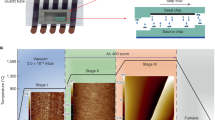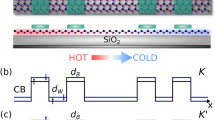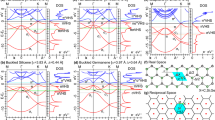Abstract
Free-standing silicene, a silicon analogue of graphene, has a buckled honeycomb lattice1 and, because of its Dirac bandstructure2,3 combined with its sensitive surface, offers the potential for a widely tunable two-dimensional monolayer, where external fields and interface interactions can be exploited to influence fundamental properties such as bandgap4 and band character5 for future nanoelectronic devices6,7. The quantum spin Hall effect3, chiral superconductivity8, giant magnetoresistance9 and various exotic field-dependent states7 have been predicted in monolayer silicene. Despite recent progress regarding the epitaxial synthesis of silicene8,9,10 and investigation of its electronic properties11,13,14,15, to date there has been no report of experimental silicene devices because of its air stability issue16. Here, we report a silicene field-effect transistor, corroborating theoretical expectations regarding its ambipolar Dirac charge transport17, with a measured room-temperature mobility of ∼100 cm2 V–1 s–1 attributed to acoustic phonon-limited transport18 and grain boundary scattering. These results are enabled by a growth–transfer–fabrication process that we have devised—silicene encapsulated delamination with native electrodes. This approach addresses a major challenge for material preservation of silicene during transfer and device fabrication and is applicable to other air-sensitive two-dimensional materials such as germanene2,3,4 and phosphorene19,20. Silicene's allotropic affinity with bulk silicon and its low-temperature synthesis compared with graphene or alternative two-dimensional semiconductors suggest a more direct integration with ubiquitous semiconductor technology.
This is a preview of subscription content, access via your institution
Access options
Subscribe to this journal
Receive 12 print issues and online access
$259.00 per year
only $21.58 per issue
Buy this article
- Purchase on Springer Link
- Instant access to full article PDF
Prices may be subject to local taxes which are calculated during checkout





Similar content being viewed by others
References
Takeda, K. & Shiraishi, K. Theoretical possibility of stage corrugation in Si and Ge analogs of graphite. Phys. Rev. B 50, 14916–14922 (1994).
Cahangirov, S., Topsakal, M., Aktürk, E., Şahin, H. & Ciraci, S. Two- and one-dimensional honeycomb structures of silicon and germanium. Phys. Rev. Lett. 102, 236804 (2009).
Liu, C-C., Feng, W. & Yao, Y. Quantum spin Hall effect in silicene and two-dimensional germanium. Phys. Rev. Lett. 107, 076802 (2011).
Ni, Z. et al. Tunable bandgap in silicene and germanene. Nano Lett. 12, 113–118 (2011).
Lin, C-L. et al. Substrate-induced symmetry breaking in silicene. Phys. Rev. Lett. 110, 076801 (2013).
De Padova, P. et al. 1D graphene-like silicon systems: silicene nano-ribbons. J. Phys. Condens. Matter 24, 223001 (2012).
Ezawa, M. Valley-polarized metals and quantum anomalous Hall effect in silicene. Phys. Rev. Lett. 109, 055502 (2012).
Liu, F., Liu, C-C., Wu, K., Yang, F. & Yao, Y. d+id′ chiral superconductivity in bilayer silicene. Phys. Rev. Lett. 111, 066804 (2013).
Xu, C. et al. Giant magnetoresistance in silicene nanoribbons. Nanoscale 4, 3111–3117 (2012).
Aufray, B. et al. Graphene-like silicon nanoribbons on Ag(110): a possible formation of silicene. Appl. Phys. Lett. 96, 183102 (2010).
Feng, B. et al. Evidence of silicene in honeycomb structures of silicon on Ag(111). Nano Lett. 12, 3507–3511 (2012).
Cinquanta, E. et al. Getting through the nature of silicene: an sp2–sp3 two-dimensional silicon nanosheet. J. Phys. Chem. C 117, 16719–16724 (2013).
Chiappe, D., Grazianetti, C., Tallarida, G., Fanciulli, M. & Molle, A. Local electronic properties of corrugated silicene phases. Adv. Mater. 24, 5088–5093 (2012).
De Padova, P. et al. Multilayer silicene nanoribbons. Nano Lett. 12, 5500–5503 (2012).
Vogt, P. et al. Silicene: compelling experimental evidence for graphenelike two-dimensional silicon. Phys. Rev. Lett. 108, 155501 (2012).
Molle, A. et al. Hindering the oxidation of silicene with non-reactive encapsulation. Adv. Funct. Mater. 23, 4340–4344 (2013).
Scalise, E. et al. Vibrational properties of epitaxial silicene layers on (111) Ag. Appl. Surf. Sci. 291, 113–117 (2014).
Li, X. et al. Intrinsic electrical transport properties of monolayer silicene and MoS2 from first principles. Phys. Rev. B 87, 115418 (2013).
Li, L. et al. Black phosphorus field-effect transistors. Nature Nanotech. 9, 372–377 (2014).
Liu, H. et al. Phosphorene: an unexplored 2D semiconductor with a high hole mobility. ACS Nano 8, 4033–4041 (2014).
Piner, R. et al. Graphene synthesis via magnetic inductive heating of copper substrates. ACS Nano 7, 7495–7499 (2013).
Acun, A., Poelsema, B., Zandvliet, H. J. W. & van Gastel, R. The instability of silicene on Ag(111). Appl. Phys. Lett. 103, 263119 (2013).
Moras, P., Mentes, T. O., Sheverdyaeva, P. M., Locatelli, A. & Carbone, C. Coexistence of multiple silicene phases in silicon grown on Ag(111). J. Phys. Condens. Matter 26, 185001 (2014).
Mannix, A. J., Kiraly, B., Fisher, B. L., Hersam, M. C. & Guisinger, N. P. Silicon growth at the two-dimensional limit on Ag(111). ACS Nano 8, 7538–7547 (2014).
Lin, C-L. et al. Structure of silicene grown on Ag(111). Appl. Phys. Exp. 5, 045802 (2012).
Gao, J. & Zhao, J. Initial geometries, interaction mechanism and high stability of silicene on Ag(111) surface. Sci. Rep. 2, 861 (2012).
Guo, Z-X., Furuya, S., Iwata, J-I. & Oshiyama, A. Absence and presence of Dirac electrons in silicene on substrates. Phys. Rev. B 87, 235435 (2013).
Resta, A. et al. Atomic structures of silicene layers grown on Ag(111): scanning tunneling microscopy and noncontact atomic force microscopy observations. Sci. Rep. 3, 2399 (2013).
Kim, S. et al. Realization of a high mobility dual-gated graphene field-effect transistor with Al2O3 dielectric. Appl. Phys. Lett. 94, 062107–062103 (2009).
Wang, R. et al. Silicene oxides: formation, structures and electronic properties. Sci. Rep. 3, 3507 (2013).
Wong, H-S. P. & Akinwande, D. Carbon Nanotube and Graphene Device Physics (Cambridge Univ. Press, 2011).
Cahangirov, S. et al. Electronic structure of silicene on Ag(111): strong hybridization effects. Phys. Rev. B 88, 035432 (2013).
Tsoutsou, D., Xenogiannopoulou, E., Golias, E., Tsipas, P. & Dimoulas, A. Evidence for hybrid surface metallic band in (4 × 4) silicene on Ag(111). Appl. Phys. Lett. 103, 231604 (2013).
Tsen, A. W. et al. Tailoring electrical transport across grain boundaries in polycrystalline graphene. Science 336, 1143–1146 (2012).
Acknowledgements
This work is supported in part by the Army Research Office (contract W911NF-13-1-0364), the Southwest Academy of Nanoelectronics (SWAN) centre sponsored by the Semiconductor Research Corporation (SRC) and the Future and Emerging Technologies (FET) programme within the Seventh Framework Program for Research of the European Commission (FET-Open grant number 270749, ‘2D-Nanolattices’ project). D.A. acknowledges the TI/Jack Kilby Faculty Fellowship. The authors thank A. Nayak and J. Wozniak of Texas Advanced Computing Centre (TACC) for their help with the three-dimensional rendering of Figure 1.
Author information
Authors and Affiliations
Contributions
E.C., D.C. and C.G. performed epitaxial growth of silicene with in situ RHEED and STM characterization. L.T. and E.C. conducted Raman spectroscopy studies on silicene stability. L.T., with D.A., devised and conducted the silicene transfer, device fabrication, transport measurements and analysis of device data. M.F. and A.M. managed the technical resources at the Laboratorio MDM, National Research Council (CNR) – Institute for Microelectronics and Microsystems (IMM), Italy. All authors contributed to the writing based on the draft written by L.T. and D.A. D.A. and A.M. coordinated and supervised the research.
Corresponding authors
Ethics declarations
Competing interests
The authors declare no competing financial interests.
Supplementary information
Supplementary information
Supplementary information (PDF 643 kb)
Rights and permissions
About this article
Cite this article
Tao, L., Cinquanta, E., Chiappe, D. et al. Silicene field-effect transistors operating at room temperature. Nature Nanotech 10, 227–231 (2015). https://doi.org/10.1038/nnano.2014.325
Received:
Accepted:
Published:
Issue Date:
DOI: https://doi.org/10.1038/nnano.2014.325
This article is cited by
-
First designing of a silicene-based optical MOSFET with outstanding performance
Scientific Reports (2023)
-
The importance of the image forces and dielectric environment in modeling contacts to two-dimensional materials
npj 2D Materials and Applications (2023)
-
Covalent bonded bilayers from germanene and stanene with topological giant capacitance effects
npj 2D Materials and Applications (2023)
-
Investigating the magnetic, thermoelectric, and thermodynamic properties of the GeCH3 single-layer considering external magnetic field, doping, and strain
Scientific Reports (2023)
-
Review of the role of ionic liquids in two-dimensional materials
Frontiers of Physics (2023)



